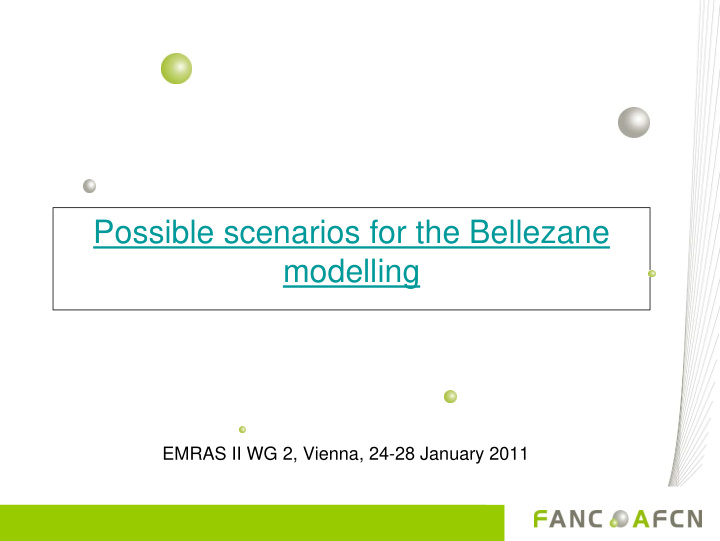



Possible scenarios for the Bellezane modelling EMRAS II WG 2, Vienna, 24-28 January 2011
Overview of site Uranium mining (underground + open pit) between 1975 and 1992 ⇒ two millions tons of rock extracted ⇒ open pit mines (MCO 68 + MCO 105) filled with U tailings between 1988 and 1992 ⇒ end of mining works in 1992 ⇒ coverage of U tailings with waste rocks and a vegetal layer in 1995-1996
Source term Total area (MCO 68 + 105) ~12 ha Successive layers: vegetal cover, waste rock, tailings + (only MCO 105) concrete basement between additional tailings layer. No grouting or additional liners to prevent groundwater percolation. 0.1-0.2 m 2 m 2 m 0.1-0.2 m 12 m
Source term (2) a) MCO 98 - Compacted waste rock: 0.5 Bq/ g U-238 + daughters Permeability: K = 2.8 10 -7 m/s Tailings: 1.6 Bq/ g U-238 + 32 Bq/ g Ra-226 - b) MCO 105 Compacted waste rock: 0.6 Bq/g U-238 + daughters - First layer tailings: 5 Bq/g U-238 + 14 Bq/g Ra-226 - Second layer tailings: 1.6 Bq/g U-238 + 32 Bq/g Ra-226 -
Transfer data: hydrogeology Water flow - Catchment area of site: ~ 120ha - Granitic soil - Average piezometric level: + 360m
Transfer data: hydrogeology Water balance Infiltration over mine catchment area: 27 m 3 /h Infiltration over catchment Infiltration over catchment area of B100: 4.5 m 3 /h area of B100: 4.5 m 3 /h Supply via Supply via groundwater: groundwater: 2 m3/h 2m 3 /h Infiltration through waste Run-off over MCO 105: Outflow from V105: 2.5 m3/h rocks and residues: 3 m 3 /h 3 m3/h Outflow from B100: 9.5 m 3 /h Outflow from BD200: 44 m 3 /h Supply via groundwater: 14 m 3 /h Direct discharge through the fractures/jointing/unplugged galleries or exploration drill holes: 0.3 m 3 /h
Transfer data • Site-specific data about climate • No site-specific data over K d • No site-specific data over transfer-factors to animals and plants • Monitoring data: see Thierry’s presentation
Exposure scenarios 1. Current impact Representative person: inhabitant of village
Exposure scenarios Radiological impact on an adult living and working in the village - Walking on site half-an-hour/ day - Quarter of diet: locally grown products (irrigated in summer with well-water) - Meat (rabbits, poultry, beef, sheep + deer, boar) all fed from local contaminated pasture/grain, well water. Fish from local contaminated streams ⇒ Total dose ? Most important exposure pathways ? ⇒ Radionuclides concentration in groundwater, streams, meadows ?
Exposure scenarios 2. I ntrusion scenario Dwelling on site Family lives and works on site, grows some vegetables in their own garden (quarter of diet) ⇒ Total dose ? Most important exposure pathways ? ⇒ Radionuclides concentration in home-grown vegetables ? ⇒ Local meat and fish exposed to radionuclides from pasture, well water, streams?
Recommend
More recommend